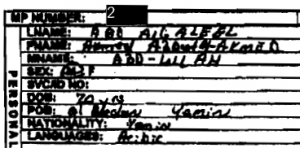Going to Jihad with the Medical Records You Have, Not the Jihad Fighters You Might Want
I want to apologize to Janice Rogers Brown. In this post, I suggested she agreed with the argument the government used to dismiss evidence that corroborated Adnan Farhan Abd al Latif’s explanation for why he traveled to Afghanistan.
As I explained, Latif’s US intake form recorded that he had medical records with him when he was taken into US custody. Both David Tatel and Henry Kennedy found those records to corroborate the story Latif has told for a decade about why he traveled to Afghanistan: he was seeking affordable medical care to treat a head injury he had sustained in 1994. The government, however, dismissed the indication that Latif had medical records with him, suggesting that the notation provided “evidence only that Latif said he had medical records with him at the time he was seized rather than that he in fact had them.”
The government, at the same time as arguing that a report of an interrogation conducted in Pakistani custody should be afforded a presumption of regularity, was arguing that the solider that filled out Latif’s US intake form was not following the procedure laid out in the Army Field Manual. It was, in short, arguing that a Pakistani intake report should be presumed regular, but not a US military intake report.
I mistakenly assumed Rogers Brown must have accepted the government’s argument that Pakistani intake reports should be afforded the presumption of regularity but not US intake reports.
But as a newly declassified passage makes clear, that’s not what Rogers Brown did. Instead, she accepted Judge Kennedy’s treatment of the intake report as regular, but argued that the detail that Latif had medical records with him when captured reinforced her own argument that the Pakistani intake report should be presumed to be regular.
“[T]he reliability of evidence can be determined not only by looking at the evidence alone but, alternatively, by considering sufficient additional information permitting the factfinder to assess its reliability.” Bensayah v. Obama, 610 F.3d 718, 725-26 (D.C. Cir. 2010). The only piece of extrinsic evidence the district court relied on does nothing to weaken the presumption of regularity. The district court found Latif was captured with medical records in his possession. based on a government document’s statement to that effect. . The record contains a medical benefits referral from Yemen’s Ministry of Defense, a “medical report” from a Jordanian Hospital confirming that Latif was admitted in 1994 for a “head injury,” and a report from Yemen’s Ministry of Public Health recommending in 1999 that Latif pursue further treatment at his own expense. This evidence corroborates Latif’s assertions about his medical condition and incidentally corroborates the Report’s description of his medical trip to Jordan-but it does nothing to undermine the reliability of the Report. The Government is tasked with proving Latif was part of the Taliban or otherwise detainable-not disproving Latif’s asserted medical condition. There· is no inconsistency between Latif’s claim that Ibrahim promised him medical treatment and the Report’s statement that Ibrahim recruited him for jihad. Both may be true. For example, Ibrahim could have promised Latif the medical treatment he needed to induce him join the Taliban.
That was awfully nice of Judge Rogers Brown, to fix the fundamental flaw in the government’s argument about presumption of regularity (that is, that they weren’t even affording their own documents the presumption of regularity).
But that makes Rogers Brown’s Wizard of Oz tale even more fantastic. She argues that because some witch–posing as a good witch, no doubt–told Latif he could find a new head from a wizard in Afghanistan, and because Latif went there with medical records in tow to meet that wizard, and according to a report she finds credible never once fired a shot, that constitutes proof that our poor Tin Yemeni Man in search of an uninjured brain was a member of the Taliban.
Beware, America. Because not only did Rogers Brown’s decision permit the government to detain anyone based on any intelligence report they can conjure up, regardless of how obviously unreliable. But she has also equated searching for medical care with terrorism.



